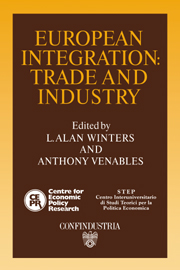Book contents
- Frontmatter
- Contents
- List of figures
- List of tables
- Preface
- Acknowledgements
- List of conference participants
- 1 European integration: trade and industry
- 2 Completing the internal market in the EC: factor demands and comparative advantage
- Discussion
- 3 External effects and Europe's integration
- Discussion
- 4 The quality and production of textiles and clothing and the completion of the internal market
- Discussion
- 5 Competition and imports in the European market
- Discussion
- 6 The structure and determinants of East–West trade: a preliminary analysis of the manufacturing sector
- Discussion
- 7 1992 and EFTA
- Discussion
- 8 Technology policy in the completed European market
- Discussion
- 9 Corporation tax, foreign direct investment and the single market
- Discussion
- 10 Japanese direct manufacturing investment in Europe
- Discussion
- Index
Discussion
Published online by Cambridge University Press: 07 September 2010
- Frontmatter
- Contents
- List of figures
- List of tables
- Preface
- Acknowledgements
- List of conference participants
- 1 European integration: trade and industry
- 2 Completing the internal market in the EC: factor demands and comparative advantage
- Discussion
- 3 External effects and Europe's integration
- Discussion
- 4 The quality and production of textiles and clothing and the completion of the internal market
- Discussion
- 5 Competition and imports in the European market
- Discussion
- 6 The structure and determinants of East–West trade: a preliminary analysis of the manufacturing sector
- Discussion
- 7 1992 and EFTA
- Discussion
- 8 Technology policy in the completed European market
- Discussion
- 9 Corporation tax, foreign direct investment and the single market
- Discussion
- 10 Japanese direct manufacturing investment in Europe
- Discussion
- Index
Summary
Introduction
The analysis of the effects of 1992 on the structure of production and on the patterns of internal and external trade is an important topic. It can best be tackled by looking at specific industries (see, for example, Emerson et al., 1988; Molle, 1990). Faini and Heimler (hereafter FH) have picked for their analysis the textile and clothing (T & C) industry. This is generally recognised as a politically very sensitive sector and is still important, particularly in the southern member states of the EC.
1992: internal trade changes
1992 means the taking away of the remaining barriers to trade between EC member states. In T &C this applies notably to non-tariff barriers, the most obvious one being the quotas, that are set within the Multi-Fibre Agreement.
In the recent past, some authors have tried to measure the impact of 1992 on the T & C industry. First to be mentioned in this respect is the IFO/PROMETEIA (1988) study on the cost of non-Europe. The conclusion of this study was that only marginally enhanced competition would result from the further opening of markets, because of the advanced state of integration already achieved. The specific influence of the abolition of the country-specific import quotas of the MFA and its replacement by EC-wide quotas would not have much effect either; Davenport (1990) estimates it to be some 3–5% of total imports. The impact is likely to be concentrated on Southern European countries.
- Type
- Chapter
- Information
- European IntegrationTrade and Industry, pp. 78 - 81Publisher: Cambridge University PressPrint publication year: 1991



